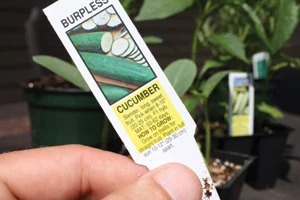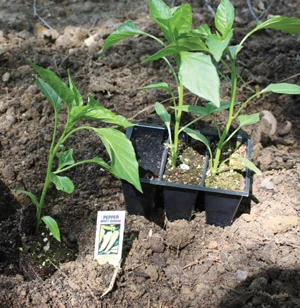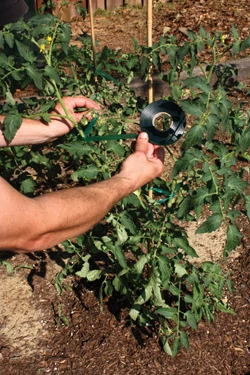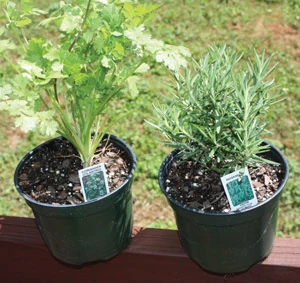By Matt Weber
I started my first backyard garden last year, having for decades watched my dad and grandfather tend large gardens of their own. I won’t claim to be an expert, but I have managed to grasp some basics that should be helpful for the first-timer. If you’re considering beginning your own garden of fruits and vegetables, the following tips should point you in the right direction.
Simplicity
If you can dig, rake, weed and water, then you have what it takes to create a successful garden. Gardening is fairly simple: Transfer plant to healthy soil, expose to sun, and add fertilizer and water, then harvest. Most beginner questions aren’t about how to garden. Most are about when. When should I plant certain seeds? When should I harvest this vegetable?

Having no academic knowledge of specific plant life cycles, growing techniques or harvesting methods, I was worried I’d have a steep learning curve to climb before I got to enjoy any fresh veggies. However, that’s not necessarily the case. Whether you’re germinating plants from seeds or planting seedlings, each purchase comes with simple printed instructions, including basic guidelines for planting depth, plant spacing, preferred climate, sun exposure, harvest time, etc. In other words, each plant comes with a “cheatsheet,” so you’ve no need to commit everything to memory. In the case of potted seedlings, the tips come on a plastic tab, which I stick in the garden soil to identify the plant type and keep its info handy.

Site Selection
Adequate sun exposure is one of the most important aspects to a garden location. Practically all of the fruits and vegetables I’ve planted, from cucumbers and zucchini to tomatoes, peppers and cantaloupe, are specified for “full sun,” meaning at least 8 hours per day. Excess shade can inhibit plant growth.

Surrounding vegetation is another issue to consider. Has the plot been cultivated in the past or is it completely overgrown and require extensive clearing? What is the site’s proximity to large trees? Complex tree root systems can steal water and nutrients from nearby plants, and the thick roots can interfere with your ability to till and turn the soil.
Water proximity is another factor. The larger your garden, the more water it will require. In arid weather, you may need access to a garden hose, lest you lug a pitcher back and forth between your plants and a water source.
Soil and climate are critical elements of gardening. Plants need fertile, rich soil with lots of warmth and sunshine. Is the soil loose and loamy, thick with clay, or dry and sandy? In terms of chemical composition, is the soil acidic, alkaline or neutral? A soil-test kit sent to a local county extension office can help you determine your soil type, so you’ll know how to improve it if necessary.

As far as climate affecting gardens, there’s not much you can control, given your geographic area. Cooler climates will have trouble growing heat-loving plants like oranges, peaches, melons, cucumbers and okra.
In hotter areas, you’ll have less luck growing cool-weather plants like raspberries, spinach and cauliflower. For the best chance of success, focus on the fruits and veggies best suited to your local climate.
Garden Design
When laying out your garden plot, focus on efficiency and accessibility. Raised beds are a common technique that enables you to sow and harvest from the footpath between them, so you never compact the soil beneath your feet.
Grass paths between growing areas can achieve a nice, manicured look if they’re properly maintained. However, this requires carefully mowing and trimming between the growing areas, which can be difficult and time-consuming.
A traditional gardening method is to arrange the plants in straight, orderly rows. However, if the rows are tightly spaced then you risk compacting the soil as you walk between them. For smaller gardens, you can lay down 6- to 8-in. wide boards between the rows on which to walk and distribute your weight over a larger surface area to avoid compaction.

It helps to sketch the dimensions of your garden design on paper to organize the layout. Consider that you need the flexibility to rotate the crops from year to year. Block in any permanent items, such as a compost bin or hardscape feature. Then, locate your rows or beds. Refer to your planting instructions when planting rows or beds, because plant species vary drastically among how much room they require to flourish.
Crop Rotation & Fertilization
Generally speaking, vegetables are planted fresh each year, and it’s wise to grow them in different places each season. Otherwise, the same crop will be continually depleting the same nutrients from the same spot. Crop rotation also lessens the likelihood that diseases or pests will become established in the soil.
Growing a garden saps a lot of nutrients from the soil. The more you grow, the more nutrients are depleted, which requires you to recharge the soil with fertilization. Compost and manure are organic material made of rotted plant material and/or animal waste. This material can be high in nitrogen and potassium and improve the structure of the soil. Many DIY’ers create their own compost in bins. If you’re beginning a garden, it may help to find a supplier in your area to jump-start your soil conditions. Last year I found a local construction aggregate supplier (who generally sells gravel, red rock, etc.) that also sold compost. I was able to purchase a cubic yard for $25, haul it in my pickup truck and unload it at my garden.
Other organic matter options include farm manure, leaf mold, even mushroom compost. Garden and home supply stores also offer a wide variety of both organic and inorganic fertilizers.

Get to Digging
These simple tips should get you started on your garden plan. You’ll also need to gear up with some simple tools such as pruning shears, a garden spade, hoe, rake, trowel and a sturdy pair of long-handle loppers. With a little hard work, sunshine and the proper plant maintenance, it’ll be picking season in no time, and you’ll never taste something as sweet.



